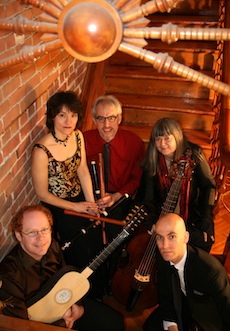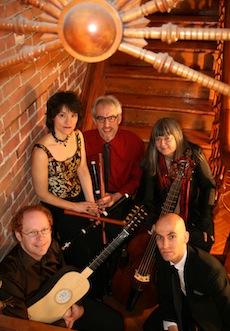
The most beloved and successful composer ever is surely Anonymous. Judging by the strong turnout for Montreal-based Ensemble Caprice on the San Francisco Early Music Society series last Saturday in Berkeley, word had gotten out that Anonymous was still up to his or her usual misdeeds. The ensemble offered a program titled “La Follia and the Gypsies: Gypsy Music in the Renaissance and Baroque Periods.” That the performance by this renowned ensemble was excellent was a given; more important, the normal constructs in classical music of great works and great composers took a back seat to the performers’ creativity.
As recorder player Matthias Maute’s frequent comments from the stage acknowledged, the program’s connection to authentic Gypsy music was often tenuous. The concert opened with several sets of variations on exotic repeating bass lines by a Spanish court composer, Diego Ortiz (c. 1510–1570). Although credited to Ortiz, they could have been by anyone, and such regular repeating harmonies “in a groove” are the foundation of modern pop and club music. Ensemble Caprice drove home the similarity through a rhythm section of Baroque guitar and percussion. Much like jazz charts, these compositions were sketches for the performers to freely improvise and interject their personalities, found in the remarkably agile and virtuosic recorder tonguing by Maute and Sophie Larivière and in the funny, whimsical, yet technically assured Baroque cello playing of Susie Napper.
Ensemble Caprice’s solution was to draw from the best of its members’ innate musicality and showmanship.
The centerpiece of the evening was actual Gypsy melodies from a 1730 collection originating in the town of Uhrovska in present-day Slovakia. The collection contains just the melodies without any of the accompanied parts (bass, harmony, and so on). It offers a rare glimpse into the practices of what Maute frequently termed “itinerant musicians” from Europe’s varied cultures — yet it is only a glimpse. How this music actually sounded 300 years ago is a matter of conjecture, as is much of early-music performance practice itself. One might imagine trying to perform jazz from a “fake book” discovered in a cave a thousand years from now without the guide of any recordings of jazz. What would good musicians create?
Drumming That Astonishes
Ensemble Caprice’s solution to resurrecting this music was to draw from the best of its members’ innate musicality and showmanship to realize a performance. This was best seen in the fascinating improvisation of Tabassian’s percussion. Tabassian specializes in the tombak, a Persian (Iranian) percussion instrument that he introduced into many of the concert’s works. He specializes in both classical percussion and traditional Persian drumming. Tabassian could produce an astonishing range of sounds from a small set of simple-looking drums in ways I could not have imagined. Most important, not one work on the concert had a dedicated percussion part; therefore, Tabassian’s drum acrobatics were purely his own. Whereas many classical composers seem to exploit percussion for the possibilities of loud, Tabassian seemed to relish in the potential of soft. His playing drew the audience in, inviting it to listen more carefully.
A concert does not have to be loud, flashy, and large to be enjoyable.
Also notable among the Gypsy melodies was a beautiful realization of the melody C 106 for solo guitar, by classical guitarist David Jacques (Anonymous is evidently not as creative with his or her titles). As stated by Maute, an engaging speaker, the melody cannot be harmonized through traditional Western means, and Jacques’ solution was an exercise in contemporary composition in and of itself. The Baroque guitar is a very soft instrument, and this drove home for me one major difference between itinerant bands of ages past and the present time: that omnipresent amplification completely distorts our experience of the relationship between instruments, and between performers and their audiences. A concert does not have to be loud, flashy, and large to be enjoyable.
Ensemble Caprice rounded out its concert with works by composers bearing recognizable names, such as Vivaldi’s Trio Sonata, Op. 1, No. 12, “La follia”; polonaises by Telemann; and dance suites by Johann Schmelzer (1623–1680); along with more familiar works by Anonymous. The ensemble’s creativity spilled over into these works, recognizing them as a springboard for the players’ own performances rather than a realization of great works by great composers in the usual classical concert sense. All the works drew from folk or exotic elements. Academic circles like to dismiss such efforts as patronizing or, worse, “Orientalist,” but Saturday’s concert showed they can also be endearing.

